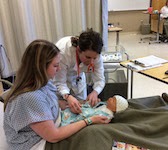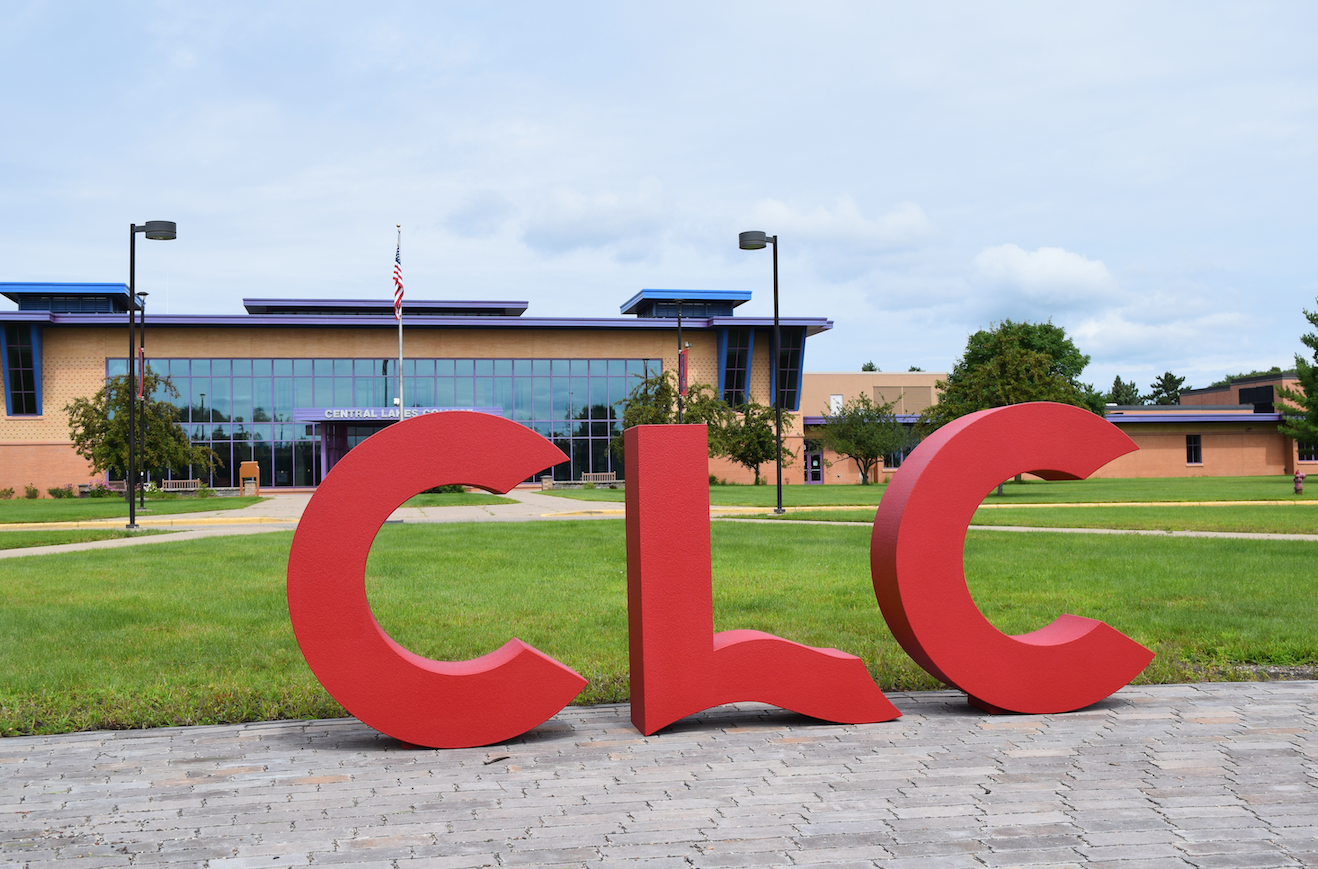A
career in nursing can be loud, fast-paced and down right chaotic.
career in nursing can be loud, fast-paced and down right chaotic.
To
learn how to better handle the evolving field, some of the nursing students at Central
Lakes College’s Brainerd campus ran through the LPN and RN Simulation Day. It’s
an event held each semester that brings in actors (students or community
members) to play the parts of patients, while faculty members evaluate how each
nurse-in-training does with each “patient.”
learn how to better handle the evolving field, some of the nursing students at Central
Lakes College’s Brainerd campus ran through the LPN and RN Simulation Day. It’s
an event held each semester that brings in actors (students or community
members) to play the parts of patients, while faculty members evaluate how each
nurse-in-training does with each “patient.”
A
classroom on the second floor of CLC is set up like a real hospital wing, with
five beds, a nurse station and medical supplies.
classroom on the second floor of CLC is set up like a real hospital wing, with
five beds, a nurse station and medical supplies.
At
last week’s event, there were five patients, each with a different story, and
each with a unique challenge for nursing students to take care of.
last week’s event, there were five patients, each with a different story, and
each with a unique challenge for nursing students to take care of.
Meet
the patients:
the patients:
* One person with congestive heart failure and trouble breathing.
* One person with alcohol withdrawal and pancreatitis.
* A 4-year-old child with a ruptured appendix that was taken out.
* A 17-year-old single mom, who just gave birth and is having
troubles with breastfeeding.
troubles with breastfeeding.
* One person with a kidney infection, nausea and pain management
issues.
issues.
Fifteen
groups of CLC nursing students ran through the hour-long process. It stars in
the “report room,” where the students play out the typical start to a hospital
shift: Handing out work tasks and talking about patients and priorities. Next,
they dove into the 20-minute simulation. The students visited with each
“patient” and addressed each need and challenges, as they arose.
groups of CLC nursing students ran through the hour-long process. It stars in
the “report room,” where the students play out the typical start to a hospital
shift: Handing out work tasks and talking about patients and priorities. Next,
they dove into the 20-minute simulation. The students visited with each
“patient” and addressed each need and challenges, as they arose.
Afterward,
the students debriefed with a faculty member in another room.
the students debriefed with a faculty member in another room.
CLC
nursing instructor Darci Goeden said each patient situation in the simulation
is very common in a real hospital. A lot of the challenges can be applied to
other situations, too, she said.
nursing instructor Darci Goeden said each patient situation in the simulation
is very common in a real hospital. A lot of the challenges can be applied to
other situations, too, she said.
The
simulation day started several years ago with a joint grant between CLC, St.
Cloud University and St. Cloud Technical and Community College.
simulation day started several years ago with a joint grant between CLC, St.
Cloud University and St. Cloud Technical and Community College.
School
leaders had three main focus goals in mind: Scope of practice, teamwork/collaboration
and culture.
leaders had three main focus goals in mind: Scope of practice, teamwork/collaboration
and culture.
Before
the simulation, there were gaps between understanding what RNs did versus LPNs,
Goeden said.
the simulation, there were gaps between understanding what RNs did versus LPNs,
Goeden said.
“And
we were missing that time where students could actually get out and experience
(a work setting) before getting out into the workforce,” she said.
we were missing that time where students could actually get out and experience
(a work setting) before getting out into the workforce,” she said.
The
simulation is typically for the folks in the program who will soon be graduating.
simulation is typically for the folks in the program who will soon be graduating.
Even though
simulation day is challenging, student Roxanne Jelinski of Little Falls wishes
it would happen more often since it’s “such a good learning experience.”
simulation day is challenging, student Roxanne Jelinski of Little Falls wishes
it would happen more often since it’s “such a good learning experience.”
“It gives me
confidence,” she said. “I still struggle with being confident.”
confidence,” she said. “I still struggle with being confident.”
Jelinski was
taking care of the patient experiencing alcohol withdrawal during the
simulation event. Even though he was agitated, Jelinski said her experience
with real alcohol withdrawal patients helped. She works at a St. Cloud
hospital.
taking care of the patient experiencing alcohol withdrawal during the
simulation event. Even though he was agitated, Jelinski said her experience
with real alcohol withdrawal patients helped. She works at a St. Cloud
hospital.
A new experience
was taking care of the little girl at the simulation day. Jelinski doesn’t
typically get assigned to pediatric patients at the St. Cloud hospital.
was taking care of the little girl at the simulation day. Jelinski doesn’t
typically get assigned to pediatric patients at the St. Cloud hospital.
Still, Jelinski
said she eased the tension in the simulated situation by answering the mom’s
questions and interacting with the little girl, letting her use a toy stethoscope
to listen to Jelinski’s heart.
said she eased the tension in the simulated situation by answering the mom’s
questions and interacting with the little girl, letting her use a toy stethoscope
to listen to Jelinski’s heart.
Jelinski is in
the PN program, but was just accepted into the RN program at CLC. She’ll start
that in the fall.
the PN program, but was just accepted into the RN program at CLC. She’ll start
that in the fall.
The simulation
day offers “very realistic situations,” Jelinski said.
day offers “very realistic situations,” Jelinski said.
“It’s valuable.
It puts what we’re learning to real life situations,” she said.
It puts what we’re learning to real life situations,” she said.
Student Kelly
Lindgren of Sauk Rapids, who is the ADN
program, acted as the charge nurse, or leader of the unit, during her team’s
simulation.
Lindgren of Sauk Rapids, who is the ADN
program, acted as the charge nurse, or leader of the unit, during her team’s
simulation.
It went smooth,
she said, even though it can be a little challenging.
she said, even though it can be a little challenging.
“It is always better to practice and make mistakes then to harm
a patient because of the unknown. As awkward as it is acting for many of
us, it is essential and will be a part of your role as a nurse as long as you
practice,” she said.
a patient because of the unknown. As awkward as it is acting for many of
us, it is essential and will be a part of your role as a nurse as long as you
practice,” she said.
The simulation
opened Lindgren’s eyes to how stressful and busy an
actual day on the job can be.
opened Lindgren’s eyes to how stressful and busy an
actual day on the job can be.
“Situations
can change dramatically with patients and nurses of all types need to be
prepared to handle rough situations,” she said. “This doesn’t mean that we have
to have all the right information but we need to be prepared to react in a
manner that reflects positive and safe patient care.”
can change dramatically with patients and nurses of all types need to be
prepared to handle rough situations,” she said. “This doesn’t mean that we have
to have all the right information but we need to be prepared to react in a
manner that reflects positive and safe patient care.”
Her advice to
future students: Be calm. It’s all about learning, after all. It’s OK to make mistakes here and be challenged.
future students: Be calm. It’s all about learning, after all. It’s OK to make mistakes here and be challenged.
“This
is the place to practice and feel safe as a student,” she said.
is the place to practice and feel safe as a student,” she said.
Goeden
said with the simulation, students learn to work together, to prioritize what
has to be done first and they don’t have to feel embarrassed if they make a
mistake.
said with the simulation, students learn to work together, to prioritize what
has to be done first and they don’t have to feel embarrassed if they make a
mistake.
“You
learn from it, so the next time they are in that situation, they know how to
react,” she said.
learn from it, so the next time they are in that situation, they know how to
react,” she said.
“It’s
important that by the actual time they go to work as an RN and LPN, they know
what it’s like in the real world work place,” she said.
important that by the actual time they go to work as an RN and LPN, they know
what it’s like in the real world work place,” she said.
 CLC News The news and events from Central Lakes College
CLC News The news and events from Central Lakes College




